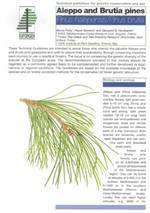Pinus halepensis and Pinus brutia - Technical guidelines for genetic conservation and use for Aleppo and Brutia pine
Current conservation measures undertaken at national levels most commonly include in situ gene conservation networks specifically designed for the target species (e.g. in Turkey, 52 P. brutia conservation units) and forest reserves or national parks which include the target species. Ex situ measures include clonal archives, cold storage seed banks and DNA banks.
To increase the efficiency of in situ genetic resource conservation, a concerted management effort should be carried out range-wide. Although transfer of seed material is often legally possible, it should be avoided across zones and countries with different ecological requirements, notably because of cold, drought and insect damage risks.
Locally, some populations require specific attention and appropriate forestry practice.
Marginal populations. As populations at high altitudes, in desert margins and mixed forests may contain valuable genes (resistance to drought, cold, pests) for adaptation under global warming, efforts such as gene reserves should be made to conserve them.
Population under recurrent forest fires. Because they are adapted to forest fires, both pines usually regenerate well after fire, using the seed bank released from serotinous cones. If regeneration happens to be poor in the first 2 years after fire, and if only a few isolated seed trees remain in the burnt area, artificial regeneration should be used to counteract the risk of genetic erosion in the juveniles. In this case, seed lots collected from large genepools should be used (e.g. at least 30 trees per population from at least three populations from a single seed zone).
Populations where hybridization may occur. Planting Aleppo pine where Brutia pine is present should be avoided in areas where frost and potential pest damage are limiting factors, or strictly monitored in areas where drought is the limiting factor. Owing to the anisotropy of between-species gene flow, the impact should be reduced when planting Brutia pine in the vicinity of Aleppo pine forests.
Authors: Bruno Fady; Hacer Semerci; Giovanni Giuseppe Vendramin
Corporate Author: European Forest Genetic Resources Programme; International Plant Genetic Resources Instit., Rome (Italy)
Journal/Series: EUFORGEN Technical Guidelines for Genetic Conservation and Use
Publication Year: 2003
Publication Format: Folder; PDF
ISBN: 92-9043-571-2
ISBN 13: 978-92-9043-571-6
Language: EN
Pages: 6 p.

